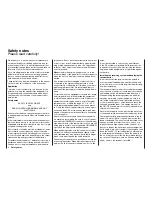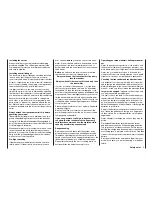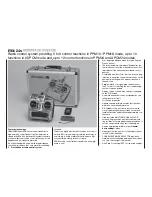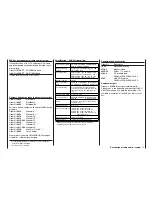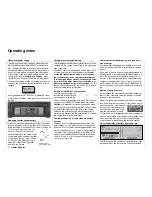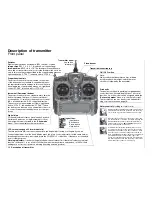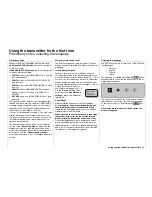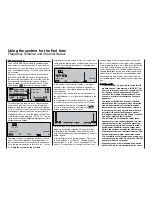
18
Operating notes
DSC socket
Direct Servo Control
Model name
#01 0:30h SPCM20
H-J.Sandbrunner
10.2V
0:30h
0
0
0
0
Stop watch
Flight tim
0 00
0 00
:
:
DSC
3. Connect the other end of the connecting lead to
the desired device, taking into account the opera-
ting instructions supplied with that equipment.
4. If you wish to use the Diagnosis lead, Order No.
4178.1
, do not connect it directly to the receiver.
First connect the lead to a receiver battery using a
Y-lead (
3936.11
or
3936.32
), then connect this to
the receiver’s battery input socket instead of the
receiver battery. The end with the barrel plug can
then be connected to the appropriate socket on
the back of the transmitter.
Once the transmitter is connected to the recei-
ver as described above, you can check the con-
trol functions or make changes to settings even
if another pilot is using “your” frequency. Since in
this state (power = “
OFF
”) the transmitter does
not broadcast a radio signal, you can, for examp-
le, prepare your model ready to fl y without causing
interference to other modellers. Another advan-
tage is that the transmitter’s current drain is redu-
ced, since the transmitter’s RF section is not acti-
ve in this mode of operation. The use of Diagnosis
mode therefore extends the operating time of the
transmitter battery considerably.
Important:
Ensure that all the cables are fi rmly plugged in.
Note regarding fl ight simulators:
The range of fl ight simulators available commercial-
ly is now very wide, and you may fi nd that it is neces-
sary to swap over the contacts at the barrel plug or
the DSC module. This work must be carried out by a
The original function of this socket was for “Direct
Servo Control”, and that’s why the abbreviation is still
in use. However, it is now much more versatile than
simply providing a means of controlling servos by ca-
ble. The two-pole DSC socket of the
mx
-24s is now
also used as the Teacher
or
Pupil socket in a Trainer
system (see page 150), and as an interface for fl ight
simulators.
For the DSC connection to work you must check
the following:
1. Carry out any adjustments required in the approp-
riate menus:
If you are connecting the transmitter to a fl ight si-
mulator, or if you are using the
mx
-24s transmit-
ter as a Pupil transmitter in a Trainer system, then
you must set the transmission mode to “
PPM18
” in
the “Modulation” line of the »
Base setup model
«
menu. However, if you wish to connect a Diagnosis
lead (Order No.
4178.1
), the “
Modulation
” must
be selected to suit the receiver.
2.
Always leave the transmitter’s On / Off switch
in the “OFF” position in such cases
, because
otherwise the RF section of the transmitter module
will not be switched off (no RF signal) even when
the DSC lead is plugged in. This is particularly im-
portant if you are using a Diagnosis lead or a Trai-
ner lead, because your transmitter may otherwise
cause interference to other pilots. Only when the
mx
-24s transmitter is in Teacher mode should the
transmitter be switched on before the Trainer lead
is connected (see page 150).
Connect the appropriate two-pole lead to the
transmitter’s DSC socket. This action renders the
transmitter and the LCD screen ready for use, cir-
cumventing the channel select process. At the
same time the screen shows the message “
DSC
”
instead of the usual display of the selected trans-
mission channel.
GRAUPNER Service Centre.
Caution:
Certain receivers – such as the R16SCAN – fea-
ture a battery socket to which a servo can also be
connected via a Y-lead. It is not possible to use a
DSC lead with this type of receiver.
Summary of Contents for mx-24s
Page 1: ...1...
Page 19: ...19 For your notes...
Page 35: ...35 For your notes...
Page 41: ...41 41 For your notes...
Page 57: ...57 For your notes...
Page 63: ...63 63 For your notes...
Page 69: ...69 69 For your notes...
Page 85: ...85 85 For your notes...
Page 99: ...99 For your notes...
Page 143: ...143 For your notes...
Page 191: ...191 For your notes...
Page 212: ...212 212 For your notes...
Page 213: ...213 213 For your notes...
Page 214: ...214 For your notes...
Page 216: ...216...

